3.7 Comparing the Roman Empire and Han Dynasty
-
9 Activities
-
3 Videos
-
6 Articles
-
3 Visual Aids
-
1 Assessment
Update ahead! This course will be updated soon. See what's changing.
Introduction
Now that you have a grip on the different—and similar—ways the world’s empires have risen to greatness, we’ll get a more detailed look at two, together. One is often referenced in film and literature in the United States: The Roman Empire. The other is a big deal in China: The Han Dynasty. They were connected to each other despite thousands of miles in between, but they remained pretty different in many ways. Women’s roles are a crucial, if often overlooked, aspect of historical study and this lesson offers some excellent evidence for how women were viewed and what roles they played in these empires.
Learning Objectives
- Analyze and compare the formation and characteristics of the Roman Empire and Han dynasty China.
- Utilize the historical thinking practice of sourcing to evaluate primary source material.
- Explain and compare the roles of women in classical societies such as Rome and Han dynasty China.
- Use a graphic biography as a microhistory to support, extend, or challenge the overarching narratives from this time period.
- Identify analysis, evidence, and WHP concepts in historical writing.
- Create and support arguments using historical evidence to evaluate the role of several philosophies and their influence on how a state should be ruled.
Redraw the Frames
Preparation

Purpose
Working with frames allows you to understand how and why people lived the way they did throughout history. They help you recognize how communities (such as societies and nations); networks (such as those for trade and exchange); and the production and distribution of goods, impacted, and still impact, people in different parts of the world. Viewing history through frames gives us a usable knowledge of history that allows us to make sense of the world today and think critically about the future. The process of depicting frames by drawing them—mixing language with imagery—will make the information more memorable.
Process
In this activity, you will draw the course frames, much like you did earlier in the course. However, instead of coming up with your own ideas about each of the frames, you will draw them according to the frame narratives at this point in the course. This will not only help you gain a sense of your understanding of the frames, but will also give you a chance to review what you’ve already learned, which will help you remember all that stuff!
Don’t worry about your drawing skills—you don’t have to be an artist to complete this activity. However, try to use more pictures than words. And feel free to be creative! Here are the criteria:
- Draw a representation of community based on the content of this era. Be sure to label that area of the picture with “community.”
- Draw a representation of production and distribution based on the content of this era. Be sure to label that area of the drawing with “P&D.”
- Finally, draw the networks between communities (people, states, empires, and so on) based on the content of this era.
- Where possible, use arrows and other lines to show movement. This will largely apply to P&D and networks.
Once you’re done, be ready to share your drawings and thinking behind them with your class. Was your approach the same as your classmates? Or did you think about the frames differently? Frames are no different from anything else we study in history—there can be many perspectives on the same topic.
The Roman Empire. Or Republic. Or…Which Was It? Crash Course #10
Vocab Terms:
- consul
- empire
- legion
- patrician
- plebeian
- reform
- republic
- senate
Summary
Julius Caesar crossed the Rubicon, destroyed the Roman Republic, and turned it into an empire before getting stabbed a bunch of times. Or did he? Well, he definitely crossed the Rubicon and got stabbed, but did Caesar actually make Rome an empire? In this video, John Green discusses Caesar’s rise to power and argues that Rome already was an empire way before Julius Caesar crossed a river and stuck some leaves on his head.
The Roman Empire. Or Republic. Or... Which Was It? Crash Course World History #10 (11:38)
Key Ideas
Purpose
This video provides evidence through a case study of Rome for responding to the Era 3 Problem: “How did new complex societies develop and what was their impact on humans both inside and outside these communities?” In particular, it explores how changes within an empire influenced the expansion of that empire. It also explores how changes in peripheral parts of the empire could change political structures in its center. This video will allow you to extend the communities frame narrative to investigate the internal and external forces that make an empire an empire.
Process
Preview – Skimming for Gist
As a reminder, open and skim the transcript, and read the questions before you watch the video.
Key Ideas—Understanding Content
Think about the following questions as you watch this video.
- What were the two classes in Roman society?
- What was a dictator and what were they supposed to do?
- What was the source of Julius Caesar’s power? What events allowed him to become sole ruler of Rome?
- Why didn’t the assassination of Julius Caesar restore the Roman Republic?
- According to John Green, when did Rome became an empire?
Evaluating and Corroborating
- This video makes it seem like the Roman Empire happened by accident. How does that compare to what you know about the other empires you’ve encountered in this era?
- Does an empire need to think of itself as an empire in order to act like an empire?
The Roman Empire
Vocab Terms:
- citizen
- dictator
- empire
- network
- senate
- silk
Preparation
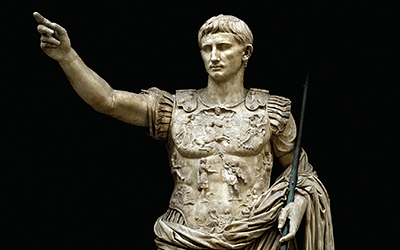

Summary
We often hear about how Rome was a republic until the republic fell and Rome became an empire. But the truth is, Rome was an empire way before some guy in a toga started calling himself emperor. Roman rule expanded across the Mediterranean world, governing millions of citizens and noncitizens. Their conquests changed Roman society, culture, and religious practices. Under the Pax Romana, a huge trade network unfolded across Eurasia, connecting trade networks from Rome to places as distant as China and the Indian Ocean. Rome’s rule lasted for centuries, and its influence lasted even longer.
Purpose
This article is one in a series of articles exploring different ancient empires. Together, these articles will provide you evidence to respond to the Era 3 Problem: “How did new complex societies develop and what was their impact on humans both inside and outside these communities?” Each article examines the characteristics of one empire: its origins, administration, trade, religion, and the place of women in society. As you read, pay attention to how these empires compare to each other and to the definitions and characteristics of an empire, presented earlier in this lesson. Be on the lookout for connections linking these different empires.
Process
Preview—Skimming for Gist
Fill out the Skimming for Gist section of the Three Close Reads worksheet as you complete your first close read. As a reminder, this should be a quick process!
Key Ideas—Understanding Content
For this reading, you should be looking for unfamiliar vocabulary words, the major claim and key supporting details, and analysis and evidence. By the end of the second close read, you should be able to answer the following questions:
- What was the Pax Romana?
- How did Rome’s wars of conquest shape Roman society?
- How did the Romans approach to religion help them create an empire?
- According to the author, what does silk tell us about women in Roman society?
- When did the Roman Empire fall?
Evaluating and Corroborating
At the end of the third close read, respond to the following questions:
- You read an article about authority and control in empires. What are some methods of control mentioned in that article that you see reflected in the Roman Empire? Did Rome use any methods of control that weren’t mentioned in the earlier article?
- You’ve read some definitions and characteristics of empires. What aspects of the Roman Empire seem characteristic of all empires? What seems unique?
Sourcing – “The Deeds of the Divine Augustus”
Preparation

Purpose
In this activity, you’ll continue to develop your sourcing skills by analyzing a primary source document written by the Roman emperor Augustus. You’ll assess the reliability of a source by examining how the historical context and purpose of a source impacts credibility. This information will help you, in your role as historian, determine how to use—or not use—the document to help understand and tell the story of a particular historical period.
Practices
Claim testing
Claim testing is an integral part of sourcing. In order to evaluate a source, we must use intuition, logic, authority, and evidence to analyze the document in order to understand the source’s point of view and reason for writing.
Process
Since this activity is your introduction to using the Sourcing Tool for a historical document, your teacher will guide you through the process. In this activity, you’ll read a primary source excerpt, complete the Sourcing Tool focusing on historical context and purpose, and craft a response to a prompt.
Before you get started, think about why you should even bother with sourcing. Sourcing helps us understand the past by analyzing the evidence that people or societies left behind. Sometimes, this evidence is limited and as a result, we have to draw conclusions by carefully evaluating sources and artifacts. Other times, there is a lot of evidence or there are sources to help us explain a historical event or process. But even if we have lots of source material, we still have to analyze the sources to understand their different points of view and perspectives. Sometimes people refer to different points of view as author bias. But we should remember that all primary source material has some bias—we all have lenses through which we view the world, and those viewpoints can help us better understand the point someone is trying to convey. In history, this can help us construct a clearer account of the past.
In this case, you’re going to read a primary source document as a class so you can answer the question, To what extent can we trust an author who is celebrating their own accomplishments?
The idea here is to figure out how much we can rely on someone’s account of something when what they are mostly doing is patting themselves on the back. Take out the text (excerpts from The Deeds of the Divine August), review it as a class, and then see if you can come up with an answer to the question based on what you’ve read. This may be hard to do—and that’s OK! You’re going to answer the same question again later, but only after you’ve sourced the document like a historian would. Now, take out the Sourcing Tool (which is incorporated into the Sourcing—The Deeds of the Divine August worksheet) and really focus on the Historical Context and Purpose rows. Go through the worksheet with your class, and then revisit the question:
To what extent can we trust an author who is celebrating their own accomplishments?
Think about how you might have read this text differently, or had a different perspective, after your first reading. Then, discuss the following questions with your class: Would you have a different perspective if you hadn’t gone through this sourcing process? Would you have fully understood this text without knowing the historical context in which it was written? How does knowing about the purpose and audience for the text give you a fuller picture of this text’s significance?
Finally, your teacher will break the class up into small groups of three to four students. Work with your group to answer the questions in the Why? (Importance) row of the tool. Your teacher will collect your worksheets to evaluate your sourcing skills.
Han Dynasty China
Preparation
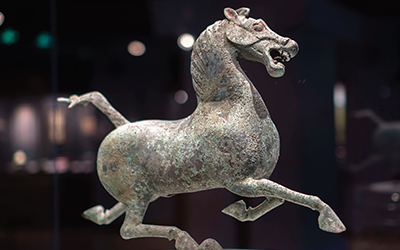

Summary
The Han Dynasty was the first to establish an imperial system in China. The emperors consolidated power by setting up an administrative system to organize the vast territory. They also combined elements of the three main Chinese philosophies of the time—Legalism, Confucianism, and Daoism—to create a sense of shared values and community amongst the Han Chinese. Despite some problems in its later years, the Han period is remembered as a golden age. Under the Han, China flourished with a reliable source of grain, increased domestic and foreign trade, intensified silk production, and a population boom.
Purpose
Learning about the creation of the imperial system and a growing sense of shared culture in Han China will help you answer the Era 3 Problem: How did new complex societies develop and what was their impact on humans both inside and outside these communities? As you read, consider how changes in one community can reshape long-distance connections among different communities. This article will also explore the central theme of this lesson, which is comparing the two main empires—Han China and Ancient Rome—that were located at either end of the Silk Road trade network.
Process
Preview—Skimming for Gist
Fill out the Skimming for Gist section of the Three Close Reads Worksheet as you complete your first close read. As a reminder, this should be a quick process!
Key Ideas—Understanding Content
For this reading, you should be looking for unfamiliar vocabulary words, the major claim and key supporting details, and analysis and evidence. By the end of the second close read, you should be able to answer the following questions:
- What types of state and communal structure existed prior to the formation of the Han Dynasty in China?
- What types of philosophies did the Han rulers adopt and why was it an advantage to incorporate multiple philosophies instead of just one?
- What innovations in farming and trade developed during Han rule?
- Who were the Xiongnu and how did the Han attempt to deal with this group?
- How are the Wang Interregnum and the Mandate of Heaven interconnected?
- What issues eventually led to the fall of the Han Dynasty?
Evaluating and Corroborating
At the end of the third close read, respond to the following question:
- How did the Han Dynasty create stability and prosperity in China? How did this new stability affect people inside China? What impacts did it have on people living outside of China, in other communities?
- What type of factors do you think were most important in making the Han period a golden age for China? Were changes in religious and political communities, changes in trade networks, or changes in Chinese production and distribution more important?
2,000 Years of Chinese History! CCWH #7
Summary
A series of dynasties ruled China from about 150 BCE to 1911 CE. The influential Han dynasty united China for 400 years. But there were many others throughout China’s long history. In this video, John Green explores how the concept of the Mandate of Heaven affected the dynastic cycle in China. He also examines the impact of one of the main philosophies that guided centuries of Chinese leaders: Confucianism. Confucianism was based on a series of moral relationships and was linked to the Mandate of Heaven, a linkage emphasized by the Confucian scholars who wrote much of China’s history.
2,000 Years of Chinese History! The Mandate of Heaven and Confucius: Crash Course World History #7 (12:11)
Key Ideas
Purpose
John Green focuses on a few important points in this video that should help you understand both historical causation and historical perspective. History is told by those who write it, and in the case of China, Confucian scholars did most of the writing. Therefore, it is important to read this history with a careful eye and to learn about the philosophical and cultural perspectives of those who wrote it. This video will help you learn how to analyze sources as well as understand historical causation, in this case how the Mandate of Heaven relates to historical causation.
Process
Preview—Skimming for Gist
As a reminder, open and skim the transcript, and read the questions before you watch the video.
Key Ideas—Understanding Content
Think about the following questions as you watch this video:
- What evidence does John Green give to illustrate that China was the first modern state?
- What reasons does John Green give to explain the dynastic cycle (rise and fall of different Chinese dynasties)?
- What was the Mandate of Heaven?
- How does the Mandate of Heaven reinforce Confucian philosophy?
- Why was the Qin so important to Chinese history?
- Why might the brutality of the Qin have been exaggerated?
- Who was Confucius and what was his philosophy based upon?
- What are ren and li?
Evaluating and Corroborating
- John Green states that the Mandate of Heave “is a remarkably flexible explanation of historical causation.” What does he mean by this?
- This video pays a lot of attention to the sources from which we get our information about two millennia of Chinese dynasties. Who wrote these sources? Does John Green trust these sources? What kinds of information from these sources do you trust? Why?
Women and Families in Classical Society
Vocab Terms:
- abide
- elite
- inherit
- kinship
- segregate
- socioeconomic class
Preparation
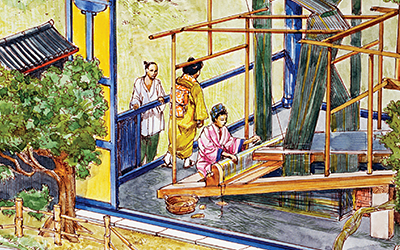

Summary
Women in the ancient world generally had less power than their male peers, but we know it wasn’t that simple. Governments and institutions might create the structures of society that tried to limit women’s roles, but many women pushed or ignored those boundaries. This article compares the lives of different women within Chinese society and concludes by comparing women and families in China to their counterparts in Rome.
Purpose
This article will provide you evidence to help you respond to the Era 3 Problem: “How did new complex societies develop and what was their impact on humans both inside and outside these communities?” In particular, the article provides an overview of differences and similarities in the lives of women in China and Rome. The article also allows you to use the lens of the communities frame narrative to evaluate how complex societies changed the lives of women in different parts of the world.
Process
Preview—Skimming for Gist
Fill out the Skimming for Gist section of the Three Close Reads worksheet as you complete your first close read. As a reminder, this should be a quick process!
Key Idea—Understanding Content
For this reading, you should be looking for unfamiliar vocabulary words, the major claim and key supporting details, and analysis and evidence. By the end of the second close read, you should be able to answer the following questions:
- Based on their written rules, which belief system gave more rights to women, Confucianism or Daoism? Give some examples.
- What do the authors mean when they say “kinship”?
- What factors determined differences between women’s lives within Chinese society?
- How were Imperial Rome and Han China similar in their treatment of women? How were they different?
Evaluating and Corroborating
At the end of the third close read, respond to the following question:
- Some historians argue that historically, paleolithic societies had high levels of gender equality. As societies became larger and more complex, that gender equality disappeared, women’s authority diminished, and their lives became worse. You’ve read a lot about empires, the largest form of complex society in this region. Do you agree that the evidence always, or predominantly, supports this assertion? Or, do you think that it doesn’t? Why or why not?
Comparative Roles of Women in Rome and Han China
Vocab Terms:
- civil war
- dowry
- elite
- empire
- submissive
- tax
- tyrant
Summary
The lack of sources often makes it hard to fully understand the lives of women in ancient societies, but we can piece together a general picture of their daily lives. This video uses a speech by an elite Roman patrician and the writing of an elite Han historian—both women—to uncover some notion of what it was like to be a woman in ancient Rome and China.
Comparative Roles of Women in Rome and Han China (10:37)
Key Ideas
Purpose
This video conducts a comparative analysis of two societies at opposite ends of Eurasia. It provides an example of how to use primary sources to compare two societies and conduct a gender analysis. As you watch, consider how the roles of elite women in Rome and Han China support or challenge the communities frame narrative you were given for this course. Think carefully about the evidence this video uses. Do you agree with the conclusions the speakers draw from these two pieces of evidence?
Process
Preview – Skimming for Gist
As a reminder, open and skim the transcript, and read the questions before you watch the video.
Key Ideas—Understanding Content
Think about the following questions as you watch this video.
- What were the arguments that Hortensia used against the triumvirate’s taxes?
- What was it specifically about this war that made Hortensia unwilling to pay for it?
- How does the video use this speech as evidence of how Roman women’s role in politics compared with other societies?
- How does Ban Zhao’s writing differ from Hortensia’s speech?
- How does Ban Zhao’s writing challenge the arguments that Ban Zhao herself was making?
Evaluating and Corroborating
- Do you think these two sources are sufficient to evaluate the role of women in these two societies? Are there any elements of Roman or Han society that they leave out?
- Ban Zhao and Hortensia were elite women. How much can their lives tell us about the lives of average women in their societies? What kinds of sources do you think we would need to know more about average women in Rome and Han China?
Babatha (Graphic Biography)
Preparation
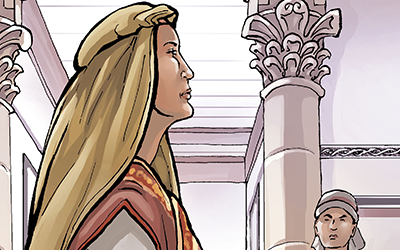

Summary
This is a biography of Babatha, a Jewish woman living during the second century CE along the southern shores of the Dead Sea. When she was a child, the Roman Empire conquered her home. Babatha stored a number of legal documents in a leather pouch that were discovered by archaeologist Yigael Yadin in 1960. They reveal valuable information about the legal status of women in this part of the Roman world. These documents capture a woman moving between different communities. They complicate our understanding of what it meant to be a woman and a subject of the Roman Empire.
Purpose
Era 3 focuses a lot of attention on empires and belief systems. Religious and political communities often developed complex legal systems. Portable belief systems and empires reshaped the communities they touched. This biography offers evidence to extend the communities frame by exploring Babatha’s encounter with two different legal systems. As you read consider how Babatha leveraged her membership in the Roman and Jewish communities to her advantage.
Process
Read 1: Observe
As you read this graphic biography for the first time, review the Read 1: Observe section of your Three Close Reads for Graphic Bios Tool. Be sure to record one question in the thought bubble on the top-right. You don’t need to write anything else down. However, if you’d like to record your observations, feel free to do so on scrap paper.
Read 2: Understand
On the tool, summarize the main idea of the comic and provide two pieces of evidence that helped you understand the creator’s main idea. You can do this only in writing or you can get creative with some art. Some of the evidence you find may come in the form of text (words). But other evidence will come in the form of art (images). You should read the text looking for unfamiliar vocabulary words, the main idea, and key supporting details. You should also spend some time looking at the images and the way in which the page is designed. By the end of the second close read, you should be able to answer the following questions:
- Where was Babatha born and who ruled this region for most of her life?
- Babatha was in court a lot. What was she fighting for?
- What kind of law did Babatha use to support her arguments, and how did she later change her strategy?
- To what degree was Babatha successful?
- How does the artist use art and design to distinguish between Roman law and Jewish law in the balloons in the center panel of the page?
Read 3: Connect
In this read, you should use the graphic biography as evidence to support, extend, or challenge claims made in this unit of the course. On the bottom of the tool, record what you learned about this person’s life and how it relates to what you’re learning.
- How does this biography of Babatha support, extend, or challenge what you have learned about communities and their impact on the people who lived in them during this period?
To Be Continued…
On the second page of the tool, your teacher might ask you to extend the graphic biography to a second page. This is where you can draw and write what you think might come next. Here, you can become a co-creator of this graphic biography!
Geography – Era 3 Mapping Part 2
Preparation

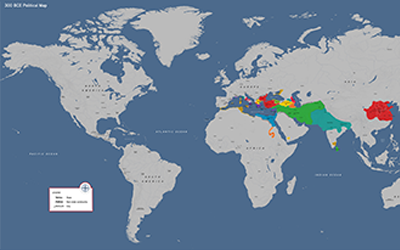
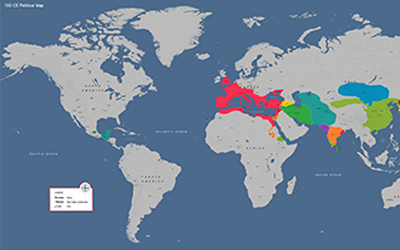
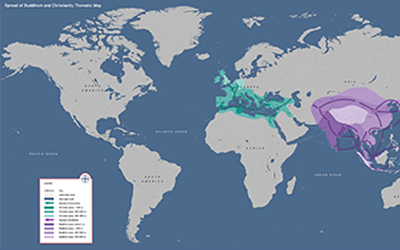
Purpose
This activity will provide additional evidence to help you respond to the Era Problem: How did complex societies develop and how did they impact humans inside and outside these communities? You will reflect back on what you have learned during this era by comparing two political maps. You will also review your predictions about complex societies and trade routes from the Era 3 Part 1 activity you completed at the start of this era. Finally, you’ll analyze a map of trade routes and the spread of religions and discuss what patterns might connect them.
Process
This activity begins with an identification opening in which you’ll identify 7 states in the year 100 CE. Next, you’ll compare the maps of political communities in 300 BCE and 100 CE as you evaluate how communities changed and stayed the same over this 400-year period. Finally, you’ll use a map of trade routes and the spread of religions to respond to a prompt.
Step 1
Individually, identify the states associated with the numbers on the black-and-white map of the world in 100 CE and record your answers on the worksheet.
Step 2
In small groups, examine the 100 CE Political Map alongside the 300 BCE Political Map that you saw in the Part 1 map activity at the start of the era. You should compare these two maps and record three significant changes or continuities on the worksheet.
Step 3
Remaining in small groups, open and review the Spread of Buddhism and Christianity Thematic Map. In the beginning of the era, you completed the Part 1 mapping activity, in which you made some guesses and predictions about ancient trade routes and complex societies. How close were your predictions? What did you get right? Finally, as small groups, you should prepare a short paragraph or bullet list in response to this prompt:
At the beginning of Era 3, there were no empires, portable belief systems, or long-distance trade. By the end of this era, all these things existed in many parts of the world—but not everywhere. Using the maps you encountered in this unit as evidence, explain how empires, trade, and the spread of religions like Christianity and Buddhism were connected in Afro-Eurasia.
Writing – Analysis and Evidence and WHP Concepts Part 1
Preparation


Purpose
In this activity, you’ll continue to get familiar with elements of good writing by digging into the Analysis and Evidence row of the WHP rubric. Additionally, you will examine the Applying WHP Concepts row of the rubric, because those concepts are integral to using evidence in this course’s writing assignments. You’ll analyze a sample student essay, which will help you become more familiar with the specific expectations for WHP writing, as well as help you become a more skilled writer in general.
Process
In this activity, you’ll take a close look at the Analysis and Evidence and Applying WHP Concepts rows of the WHP Writing Rubric and analyze a student essay against the criteria included in the rubric.
This activity will be similar to the one you did in Era 2, when you analyzed the article “The Chronometric Revolution” to look for claim and focus. This time, you’ll look for analysis, evidence, and WHP concepts in a student essay that was written in response to the prompt, “To what extent was foraging or farming more desirable for early humans?” Before starting your analysis, take out the WHP Writing Rubric and review the Analysis and Evidence and Applying WHP Concepts rows with your class.
Once you’ve reviewed these criteria, your teacher will probably put you into pairs or small groups to work collaboratively on the Writing – Analysis, Evidence, and WHP Concepts Part 1 worksheet. First, identify the major claim (thesis) in the essay. While the thesis is not the focus of this activity, it’s difficult to assess the rest of the essay without being aware of the major claim, since everything in the essay should support it.
Now that you’ve found the major claim, review the essay, paying close attention to important elements of analysis and evidence. This includes the use of source material, the analysis of that material, and the connection between sources and the paper’s major claim. Annotate the essay according to the worksheet directions, provide a grade (advanced, proficient, developing, or emerging), and comment about how well this student did on analysis and evidence in their writing. Next, look for where and how well WHP concepts were used in the essay, and again, grade and comment on the use of these concepts. Be prepared to share your answers with the class!
Analysis and Evidence Warm-Up
Preparation


Carefully read the DBQ essay prompt you will be responding to. Be sure to have read and analyzed the documents using historical thinking skills such as sourcing or contextualizing prior to doing this warm-up activity.
Make sure you have drafted the thesis/major claim you intend to use in response to the essay prompt.
Purpose
In addition to the close reading, critical thinking, and historical thinking skills you are refining throughout the course, the process of writing a DBQ will help you build important—and useful—writing skills. This warm-up focuses on the Analysis and Evidence row of the WHP Writing Rubric and gives you the opportunity to practice choosing the best evidence to support your argument. Additionally, you will practice your analysis skills to not just connect your evidence to your thesis/major claim, but also to clearly explain why this connection is significant. These evidence and analysis skills will allow you to continue to develop your ability to respond to a writing prompt, and to generally be able to more effectively support your positions and opinions.
Process
In this quick warm-up activity, you’ll practice engaging in analysis and using evidence to support your thesis/major claim when writing an essay. First, you’ll review the Analysis and Evidence row of the WHP Writing Rubric, and then, you’ll work through a three-step process to help you use evidence-backed supporting claims in support of your thesis/major claim. Your teacher may have you do this for one supporting claim or for many, depending on your familiarity with this process.
First, take out the WHP Writing Rubric and review the Analysis and Evidence row and discuss it with your class. Next, take out the Analysis and Evidence Prewriting Tool, and work through the tool together, using the DBQ prompt you’ll be responding to when you write your essay.
In Step 1, come up with a supporting claim—or reason—that supports the thesis/major claim statement you’ll be working on. Then, for Step 2, go back to the documents you reviewed or researched before this activity to find the best source to support the first subclaim. Once you’ve found the evidence, add the citation to the tool. Then, write down the specific evidence you’ll use from that document. Finally, write a reason why this evidence supports the supporting claim.
Now you’re ready for Step 3 (Reason). Write a sentence or two explaining how the evidence you found supports your supporting claim. Remember that if you aren’t quoting directly from the source, you should be sure to paraphrase and use your own words to describe the supporting evidence.
Once you have completed the steps, it’s time to write!
DBQ 3
Preparation



Era 3 DBQ: Analyze the similarities and differences between early Chinese philosophies (Legalism, Daoism, Confucianism, Buddhism) regarding how a state should be ruled.
Have the Comparison, CCOT, and Causation tools available (find all resources on the Student Resources page)
Purpose
This assessment will help prepare you for the document-based questions (DBQs) you will probably encounter on exams. It will also give you a better understanding of your skills development and overall progress related to constructing an argument, interpreting historical documents, and employing the historical thinking practices you are using in this course.
Practices
Comparison, contextualization, sourcing, reading, writing
All DBQs require you to contextualize, source documents, and of course as part of this, read and write.
Process
Day 1
In this activity, you are going to prepare to respond to a DBQ, or document-based question. In this course, document-based questions give you a prompt or question along with seven source documents, and you’ll use the information in those documents (and any additional knowledge you have) to respond to the prompt. Your responses will be written in essay format, and will usually be five or six paragraphs long.
This DBQ asks you to respond to the following prompt: Analyze the similarities and differences between early Chinese philosophies (Legalism, Daoism, Confucianism, Buddhism) regarding how a state should be ruled. To make sure you’re clear on what you’re being asked, take out the Question Parsing Tool. Work with your classmates to deconstruct the prompt.
Next, take out the DBQ and relevant thinking tool to help you analyze the documents. Take a look at the document library. As you do with the Three Close Reads process, quickly skim each of the documents for gist. Then, do a closer read of each one. For each document, write down the information you think you might use in your essay. If possible, also provide a source analysis for each document. Write your ideas on the relevant tool as you work through the documents. Discuss your ideas with the class.
Now, come up with a major claim or thesis statement that responds to the prompt. Use the information from your thinking tool to help you come up with an idea. What you have written should help you support your claim. One common mistake students make when responding to a DBQ is not directly answering the prompt—so, in creating your thesis, make sure that it directly answers and is relevant to the prompt.
Finally, it’s time to contextualize. Remember, that ALL historical essays require you to contextualize. If you need to refresh your memory, contextualization is the process of placing a document, an event, a person, or process within its larger historical setting, and includes situating it in time, space, and sociocultural setting. In this case, you are contextualizing the documents. Contextualization will often come at the beginning of your essay, or at least in the first paragraph, either before or after your thesis statement. As needed, you can use the Contextualization Tool for this part of the process.
Day 2
This second day is your writing day. Feel free to use your tools and notes from any prewriting work you completed as you craft your essay response. Make sure you have a copy of the WHP Writing Rubric available to remind you of what’s important to include in your essay. And don’t forget to contextualize! In doing that, think of the entire time period, not just the time immediately preceding the historical event or process you are writing about. Your teacher will give you a time limit for completing your five- to six-paragraph essay responding to the DBQ.
DBQ Writing Samples
Preparation

Purpose
In order to improve your writing skills, it is important to read examples—both good and bad—written by other people. Reviewing writing samples will help you develop and practice your own skills in order to better understand what makes for a strong essay.
Process
Your teacher will provide sample essays for this era’s DBQ prompt and provide instructions for how you will use them to refine your writing skills. Whether you’re working with a high-level example or improving on a not-so-great essay, we recommend having the WHP Writing Rubric on hand to help better understand how you can improve your own writing. As you work to identify and improve upon aspects of a sample essay, you’ll also be developing your own historical writing skills!
Analysis and Evidence Revision
Preparation
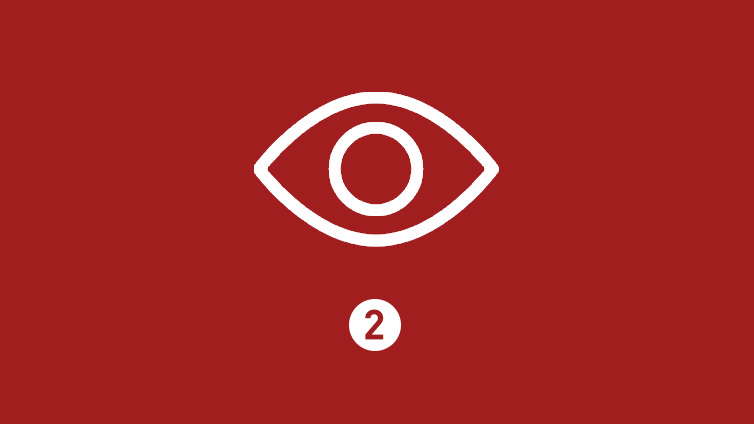

Have your graded essay ready to use for annotation and revision purposes.
Purpose
A good way to improve your writing skills is to analyze and edit writing samples using peer drafts or even your own essay. In this activity, you are given a tool to use that gives you a strategy for evaluating and revising the use of analysis and evidence in a piece of writing based on the WHP Writing Rubric. As you think critically about the criteria in the rubric and evaluate a piece of writing against it, you will develop a stronger understanding of all of the factors that make a piece or writing “good.”
Process
If you have not already reviewed the Analysis and Evidence row of the WHP Writing Rubric with your class, you’ll start by taking a close look at that section. Then, you’ll review the Analysis and Evidence Revision Tool and learn how to use it to improve upon the use of analysis and evidence in an essay. Finally, you’ll use the Analysis and Evidence Revision Tool to review and revise an essay that has been graded by your teacher or peers.
If you are reviewing the Analysis and Evidence row of the WHP Writing Rubric with your class, remember that well-placed and well-explained evidence can make all the difference in making a convincing and compelling argument.
Next, take out the Analysis and Evidence Revision Tool and walk through it with your class. First, note the directions at the top, which ask you to review the feedback from an essay. This is a helpful step because it gives you a general sense of how the essay fared in terms of analysis and evidence and where improvement is needed.
Now it’s time to go through each item on the checklist to make sure all criteria related to analysis and evidence were included in the essay. Work through the list with your class, and be sure to ask questions if you aren’t clear about what an item is asking for. Then, look to see if everything in the list is included in the essay. Only check the boxes if the criteria are met. If any criteria from the checklist were not met, leave those boxes blank. The final step is to revise the essay based on all the blank checkboxes. Use the unchecked boxes as guidance for what can be done to improve the essay. You can use the Analysis and Evidence Prewriting Tool to help structure revisions.
To give you more practice with the Analysis and Evidence Revision Tool, your teacher might have you review and revise a sample graded essay.
Once you have a solid grasp on how the tool works, you’ll repeat the process on your own graded essay.